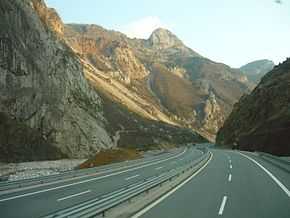Albania–Kosovo Highway
| Albania-Kosovo Highway Rruga e Kombit (AL) Rruga "Dr. Ibrahim Rugova" (RKS) | |
|---|---|
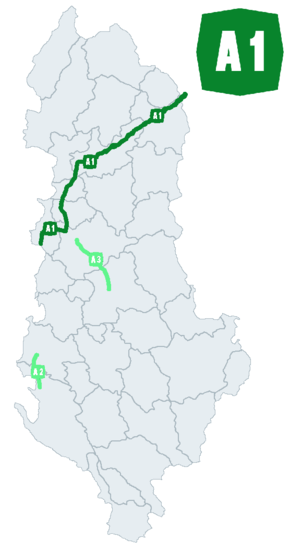 | |
|
A1 motorway along Fan River Valley | |
| Route information | |
| Length: | 272 km (169 mi) |
| Major junctions | |
| From: | Albania |
|
SH35 Laç SH23 Kukës Gjakovë/Prizren North Rahovec Suhareka Prishtina. | |
| To: | Kosovo[a] |
| Location | |
| Major cities: |
Tirana Durrës Laç Lezhë Kukës Prizren Pristina |
The Albania–Kosovo Highway (Rruga e Kombit in Albania or Rruga "Dr. Ibrahim Rugova" in Kosovo[a]), is a four-lane highway constructed from 2007 to 2013 by the American-Turkish consortium Bechtel-ENKA, Austrian, and Albanian companies between Albania and Kosovo. The highway starts near Lezhe, Albania, passes through Kukes, Prizren, and ends near Pristina at Gjergjica, Kosovo. Ultimately, the highway will connect the Adriatic Sea ports of Durres and Shengjin in Albania, with the E75/Corridor X near Niš, Serbia via Pristina as part of the South-East European Route 7.[1]
Dubbed the “patriotic highway”, the project links Albanians in Kosovo and Albania, helping to boost cultural and economic ties.[2] The project is Albania's largest in decades, costing over one billion euros. It includes a six kilometer tunnel in Albania, making travel and trade easier for the hundreds of thousands of people vacationing in Albania during summer holidays and for business.
A1/SH5 Highway in Albania
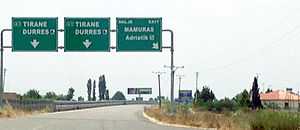
A1 motorway, known as the Nation's Highway in Albania is part of the Durres-Kukes Corridor referring to the road segments between Milot, Rrëshen, and Kalimash. Remaining segments between Kolsh, Kukës, and Morinë are part of the SH5 Highway instead linking Shkodër and Kukës. It is unclear whether the segment Thumane-Milot is part of the A1 or SH1 as road signs and map markings do not officially coincide.
In June 2009, the project was symbolically inaugurated with opening of the Kalimash - Thirrë Tunnel, while the whole project was only finished by July 2010 and the remaining portions by summer 2011. However, segment Milot-Rrëshen and several viaducts on the SH5 still remain to be expanded into dual carriageways in the near future. It is expected that the motorway will become a toll highway to upgrade remaining segments to full motorway standard and cover the costs of maintenance.
The highway is expected to reduce the travel time from six hours to two, with an estimated speed of 80–110 km/h. The highway is also expected to boost tourism in Albania and deepen the cultural and economic exchanges between Albania and Kosovo. As most tourists come through Kosovo, the laying of the highway will make it easier to travel to the Durrës and Shengjin ports, and the Adriatic Sea generally.
Rrëshen - Kalimash
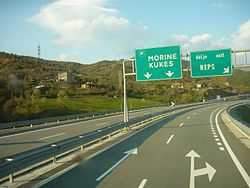
The most challenging part of the corridor was the segment between Rrëshen and Kalimash, which is around 61 km long. It was divided into three sections - a 19 km stretch from Rrëshen to Reps, 27 km from Reps to Thirrë and 15 km between Thirrë and Kolshi. A total of one tunnel and 27 viaducts have been constructed through the steep and mountainous terrain.
There are 17 viaducts in the area from Reps to Thirrë. The use of a hydro-powered electricity grid instead of diesel generators has helped in reducing the carbon footprint of the project. As a result, CO2 emissions have dropped by 613,000 lb (278,000 kg) each month. The above segment as opposed to the other ones is of a higher quality both for security and construction parameters.
Construction work on the remaining segments in Albania (Milot-Rrëshen and Kalimash-Morinë) finished in 2009. Even though in double carriageway standard, Kolsh-Morinë (SH5) lacks the standard of A1 as entry and exit ramps are missing. The viaducts along this segment will be doubled in the near future while uncontrolled entry and exit points are becoming a major safety issue.[3]
Tunnelling
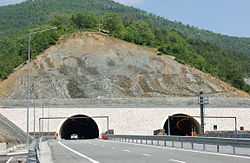
The highway passes through a 5.5 km-long double-bore tunnel. Construction works on the tunnel began in May 2007 and were completed with one tunnel tube inaugurated in June 2009. The south-bound tunnel was completed in July 2010. All four faces of the two tubes of the tunnel have been worked on simultaneously. Rrëshen - Kalimash segment's third section of road between Thirrë and Kolshi included Mt. Runes at an elevation of 1,858m. Laying road on Mt. Runes proved to be a challenge for the engineers. Another challenge was the transportation of construction equipment and material. As about 3,800 people worked on the project, there was the additional responsibility of feeding, clothing and housing them. A partial collapse occurred at a 50m section in the central-south bore of the tunnel in November 2009. No injuries or equipment damages were reported. The collapse occurred because of heavy overbreak (during excavation) at a geologically complex area inside the tunnel and delayed the completion of the south-bound tunnel. During the tunnel construction, the tunneling team encountered five types of rock. In fact, only the north-bound tunnel was opened as per schedule in June 2009.
Funding and Contractors
The highway project is the biggest road infrastructure project ever done in Albania. Its initial cost was estimated at €600m but during the course of construction this has more than doubled. The project was financed by the government of Albania and some foreign lending institutions. The total cost of the highway is estimated to be over €1bn ($1.4bn). amid allegations of corruption and a growing public debt.[4]
The contract for the construction of road segment between Rreshen and Kalimash, which constitutes one-third of the whole project, was awarded to a joint venture between Bechtel, a US-based engineering company, and Enka, a Turkey-based construction company. The contract was awarded in September 2006 and a majority of the construction works were completed by June 2009. Contractors working in the remaining portions of the highway were Albanian and Austrian based firms. The motorway in Kosovo is being constructed by Bechtel-Enka as well.
R7 Highway in Kosovo
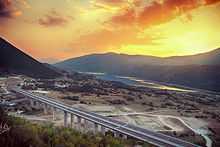
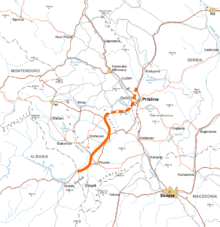
Construction of the Kosovo portion of the highway numbered R7/E851 and named Dr Ibrahim Rugova Highway started in April 2010. It was finished in November 2013 with the Vërmicë-Pristina segment ending in Gjurgjica at the M9. The highway is seen as part of the larger Vërmicë-Merdare Corridor ending at Merdare border crossing with Serbia in eastern Kosovo. R7 is 118 km long at a cost of 700 million euro/ $937 million. This highway will set the travel time from Prishtina to Tirana to 3 hours.[5]Once the remaining E80 Pristina-Merdare section project will be finalized and completed, the motorway will link Kosovo through the present E80 highway with the Pan-European corridor X (E75) near Nis, Serbia.
Impact
Since the end of the Kosovo War of 1999, hundreds of thousands of Albanians have passed through the poor old mountain road to get to Albania's beaches.[6] Building a highway would "crystallize a year-round tourism industry and double the size of the Albanian market", while allowing both communities to rationalize agriculture.[6] Travel times are expected to be lowered to two and a half hours or less, down from seven.[6]
Once finalized, the project will link the Adriatic Sea with the Pan-European corridor X at the E80 near the town of Merdar between the contested Kosovo-Serbia border.
US Congressman Eliot Engel has compared Sali Berisha's vision to build this highway to that of Eisenhower to build highways across the United States.[7]
Exit list
| Type | Name | Destination | Notes | ||
|---|---|---|---|---|---|
| | |||||
| Europa Park Rest Area | Accessible northbound only | ||||
| |
Fushe-Mamurras | Connection to Mamurras and Patok near Adriatik | |||
| Laç | Connection to Laç, Shna Ndout Church, and Patok Lagoon-Fushe Kuqe Reserve | ||||
| Fushe-Milot | Temporary roundabout connecting with Shkoder and Lezhe | ||||
| Milot | Connection to Lezhe to the north, and Lac to the south | ||||
| Skuraj | Connection to Burrel, Peshkopi, and Ulez Lake Regional Nature Park | ||||
| Rubik | Connection to Rubik, Katund i Vjeter area, and nearby Berzane Reserve | ||||
| Rreshen | Connection to Rreshen and Lura National Park to the south, and the old alternate Qafa Malit route to the north | ||||
| Reps | Connection to old Qafa Malit route towards Puka and Fushe-Arrez | ||||
| Fan | Connection to Klos and Zall-Xhuxha, Fan area | ||||
| Kastrati Rest Area | Accessible eastbound only | ||||
| Thirre/Kalimash Tunnel | |||||
| Kolsh | Connection to Fushe-Arrez and Puka | ||||
| | |||||
| Prizren jug | M25 | Connection to Prizren South and Skopje, Macedonia | |||
| Prizren veri | R107 | Connection to Prizren North, Pec, and Dakovica | |||
| Suhareke | R117 | Connection to Suhareka and Theranda | |||
| Duhel | M25 | Connection to Duhel/Dulje and Shtime/Stimlje | |||
| Malisheve | R119 | Connection to Malisheve | |||
| M9 Gjurgjica – Sllatine e Madhe – Fushe Kosove | |||||
| Fushe-Kosove | M9 | Connection to Pristina and Kosovo Polje | |||
| Pristina | M2 | Connection to Pristina Northwest and Kosovska Mitrovica | |||
| M25/E80 Pristina - Besiane - Merdare (enter Serbia) | |||||
| 1.000 mi = 1.609 km; 1.000 km = 0.621 mi | |||||
Notes and references
Notes:
| a. | ^ Kosovo is the subject of a territorial dispute between the Republic of Serbia and the Republic of Kosovo. The latter declared independence on 17 February 2008, but Serbia continues to claim it as part of its own sovereign territory. Kosovo's independence has been recognised by 108 out of 193 United Nations member states. |
References:
- ↑ http://ec.europa.eu/enlargement/pdf/projects-in-focus/donor-coordination/2-3_april_2009/working_group_transport_seeto_en.pdf
- ↑ http://www.balkaninsight.com/en/article/albania-plans-tolls-for-kosovo-highway
- ↑ http://www.youtube.com/watch?v=Ya5ksd2ADIk
- ↑ http://tiranatimes.com/old_site/index.php?id=180
- ↑ KosPress (2010-06-08). ""Rruga e Kombit" filloj edhe në Kosovë" (in Albanian). KosPress.
- ↑ 6.0 6.1 6.2 Benet Koleka (June 28, 2007). "Highway set to bring Albania and Kosovo closer". Reuters. Retrieved 2009-06-13.
- ↑ "Engel: Berisha si Auzenhaur, nderton sistem autostradash ()". Koha Jone Magazine. 2010-06-07.
See also
External links
| Wikimedia Commons has media related to Category:Autostradë A1. |
- Albania Motorway Webpage at Bechtel
- Kosovo Motorway Official Website
- A1 on Motorway-ExitLists.com
- "Albania's major roadworks (text)". Euronews. 25 June 2009. - Video
| ||||||||||||||
